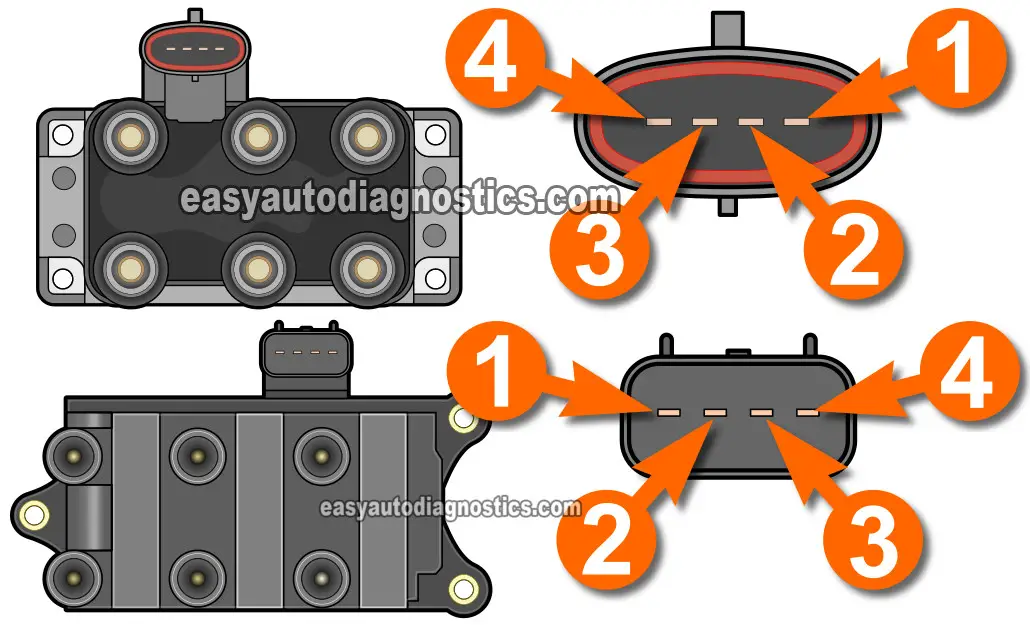TEST 5: Switching Signal Cylinders 1 And 5

In TEST 3, you confirmed that the coil pack towers, that feed cylinders 1 and 5, are not sparking.
So the next step, before condemning the coil pack as bad, is to make sure the individual ignition coil (inside the coil pack) that fires cylinders 1 and 5 is getting an activation signal from the PCM (a switching signal).
OK, here's what you'll do:
- 1
With an appropriate tool, pierce the wire that connects to the male terminal labeled with the number 3 in the illustration above.
This is the wire that feeds the switching signal to the individual ignition coil that fires cylinders 1 and 5. - 2
Connect the metal probe end of your 12 Volt test light to that tool.
NOTE: This test is performed with the Ford coil pack connected to its connector. - 3
Place the alligator clip of the 12 Volt test light on the positive (+) battery terminal.
- 4
Have your assistant crank the engine as you observe the test light.
- 5
The test light should flash ON and OFF rapidly as the engine cranks (and starts).
If all is NOT good, the test light will not flash ON and OFF at all.
Let's take a look at what your test result means:
CASE 1: The test light flashed ON and OFF. This is the correct test result and confirms that you've got a bad coil pack on your hands. Replace the it.
Here's why: So far you have verified that this particular ignition coil (within the Ford coil pack) is receiving 12 Volts and the Switching signal. With both signals present, this ignition coil (within the coil pack) cylinders 1 and 5 has to spark from its two towers. Since it's not, the whole coil pack has to replaced.
CASE 2: The test light DID NOT Flash ON and OFF. Then the Switching signal is either (1) not being generated by the ignition control module (whether it's in the computer or not) or (2) there's an open-circuit problem in the wire that is not letting the signal reach the coil pack.
With this result, you have eliminated the coil pack itself as the cause of the misfire or the no-spark condition. Why? Because without this Switching signal that particular ignition coil will not fire spark from its two towers.
TEST 6: Switching Signal Cylinders 2 And 6

You've reached this TEST step because the coil pack towers that feed spark to cylinders 2 and 6 are not sparking.
The next step, before condemning the coil pack as bad, is to check for the Switching signal for cylinders 2 and 6.
This Switching signal is the one that activates the individual ignition coil, that fires cylinders 2 and 6, to start sparking. If this signal is present, then you can assume with confidence that the coil pack is bad.
This is what you'll need to do:
- 1
With an appropriate tool, pierce the wire that connects to the male terminal labeled with the number 2 in the illustration above.
This is the wire that feeds the switching signal to the individual ignition coil that fires cylinders 2 and 6. - 2
Connect the metal probe end of your 12 Volt test light to that tool.
NOTE: This test is performed with the Ford coil pack connected to its connector. - 3
Place the alligator clip of the 12 Volt test light on the positive (+) battery terminal.
- 4
Have your assistant crank the engine as you observe the test light.
- 5
The test light should flash ON and OFF rapidly as the engine cranks (and starts).
If all is NOT good, the test light will not flash ON and OFF at all.
Let's take a look at what your test result means:
CASE 1: The test light flashed ON and OFF. This is the correct test result and it confirms that this particular ignition coil (within the coil pack assembly) is receiving the Switching signal. This means that the coil pack is bad, replace it.
Here's why: So far you have verified that this particular ignition coil (within the Ford coil pack) is receiving 12 Volts and the Switching signal. With both signals present, this ignition coil (within the coil pack) cylinders 2 and 6 has to spark from its two towers. Since it's not, the whole coil pack has to replaced.
CASE 2: The test light DID NOT Flash ON and OFF. Then the Switching signal is either (1) not being generated by the ignition control module (whether it's in the computer or not) or (2) there's an open-circuit problem in the wire that is not letting the signal reach the coil pack.
With this result, you have eliminated the coil pack itself as the cause of the misfire or the no-spark condition. Why? Because without this Switching signal that particular ignition coil will not fire spark from its two towers.
